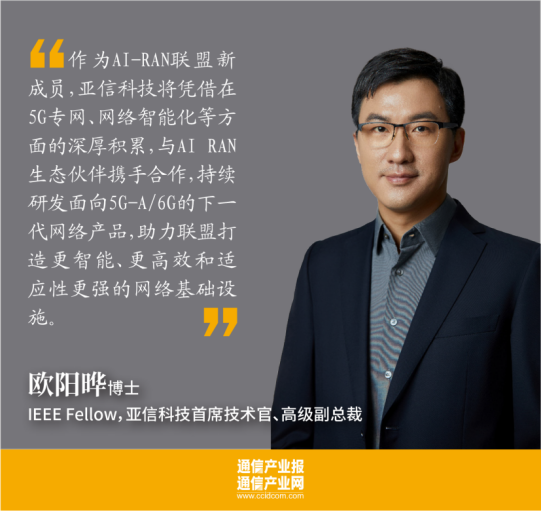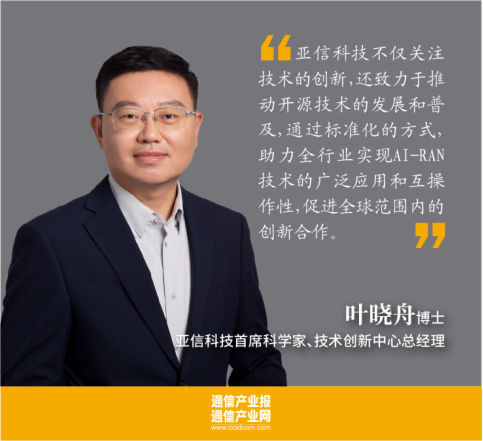2025-02-17
Recently, as the industry-leading product and service provider for private 5G network and network intelligence, AsiaInfo Technologies was officially approved to join the AI-RAN Alliance.
In early 2024, the AI-RAN Alliance was established under the leadership of NVIDIA at MWC (Mobile World Congress) Barcelona, with its members including many world-leading technology enterprises such as Amazon, ARM, Ericsson, Microsoft, Samsung and Nokia. AI RAN is committed to deeply integrating artificial intelligence into Radio Access Network (RAN) technology, promoting the intelligent evolution of mobile network, and laying the foundation for telecommunications companies to create new business opportunities by using AI in the 5G and 6G era.
01 What is the prospect of AI RAN?
AI RAN demonstrates the three core technology routes for deeply integration between AI and RAN, as follows: AI-for-RAN: Leveraging the AI technology to enhance the functionality of radio access network and improve the spectrum utilization efficiency; AI-and-RAN: Deeply integrating AI into the RAN process, and optimizing the resource allocation to create new business opportunities; AI-on-RAN: Deploying AI service at the edge of network to improve the operational efficiency and provide innovative service for mobile users.

Figure: Dr. Ouyang Ye
Dr. Ouyang Ye (CTO and SVP of AsiaInfo Technologies, IEEE Fellow) said in an interview with the all-media reporter from COMMUNICATIONS WEEKLY that AI RAN is undoubtedly one of the most eye-catching focuses in the current communication industry, and it is also one of the main routes for artificial intelligence (the hottest keyword today) and wireless communication from parallel development to deep integration.
Ouyang Ye believes that the establishment of AI-RAN Alliance is driven by industry demands and technology trends. As we know, the telecommunications industry is facing challenges such as increased network complexity, high operating cost, and sluggish growth on 5G revenue. With the rapid development of AI technology, optimizing network performance, improving customer experience, reducing power consumption and enhancing resource utilization through AI, as well as deepening the integration between AI and RAN is becoming a key path to resolving these issues. Meanwhile, creating new business modes through edge computing and AI inference, and developing the AI-driven revenue opportunities can provide a broad scope for the telecommunications industry to look for the new growth points.
From the perspective of standard evolution, when 3GPP launched the definition of R15 version in 2016, AI had already been introduced into the RAN side, with functions such as NWDAF (Network Data Analysis Function) equivalent to AI for RAN. Nowadays, R19 version is developed in terms of 3GPP standard, and AI is gradually integrated into various functional modules of wireless network, including intelligent positioning, network performance optimization, etc. Especially in the 5G Advanced defined by R18, the integration between communication, sensing, computing and intelligence has been considered as one of the key technologies. Based on this technology, the communication network can bring native sensing, computing, intelligence and connectivity integration capabilities, thereby providing ubiquitous computing power service, flexible and available intelligent application, and AI-on-RAN service for corporate customers. Meanwhile, in terms of the development for RAN technology, it shows a dual-spiral improvement trend of "Openness" and "Intelligence". AsiaInfo Technologies' AI Native ORAN solution based on O-RAN standard architecture has improved the intelligence and automation level of ORAN through technologies such as AI Native RIC and integration between communication, computing and intelligence, laying the foundation for exploring AI-Native 6G network.
In the industry, NVIDIA released a revolutionary computing device called Arc1 - "Airborne Computer" in September 2024. The equipment combines radio processing with complex wireless algorithms, aiming at resolving key challenges in wireless communication, such as limited spectrum, complex algorithms and dynamic environment. Ouyang Ye pointed out that it indicates that more and more IT vendors are attracted to cross the border into the field of communication due to the deep integration between AI and communication technology. Both traditional communication vendors and emerging IT vendors are actively promoting the development and innovation of AI RAN technology and products, thereby meeting the demands of customers for AI RAN.
Ouyang Ye emphasized that China currently demonstrates exceptional performance in the 5G field, and needs to make follow-up actively when facing the critical trend of AI RAN and further strengthen the integration between AI and communication technologies, in order to address the challenges and opportunities of future communication network while maintaining the leading position in 5G.
02 How to promote the development of AI RAN industry?
Ouyang Ye admitted that currently, the AI-RAN Alliance's scenario solutions are mainly based on communication operators' networks, promoting the development and innovation of AI-on-RAN, AI-for-RAN and AI-and-RAN, and accelerating the digital intelligent transformation of communication operators.
Ouyang Ye said that as a new member of the AI-RAN Alliance, AsiaInfo Technologies will pay more attention to the development and innovation of AI-on-RAN, AI-for-RAN and AI-and-RAN solutions for verticals' corporate private networks by virtue of its profound accumulations in private 5G network and network intelligence, and work together with AI RAN ecological partners to continuously develop the next-generation network products oriented towards 5G-A/6G and help the AI-RAN Alliance build more intelligent, efficient, and adaptable network infrastructures.
Dr. Ye Xiaozhou (Chief Scientist of AsiaInfo Technologies and General Manager of Technology Innovation Center) said in an interview with the all-media reporter from COMMUNICATIONS WEEKLY that AsiaInfo Technologies has always been committed to in-depth cooperation with industrial partners in order to promote the intelligent development of 5G and future 6G networks.
Firstly, deepening the industrial cooperation. In September 2024, AsiaInfo Technologies, Alibaba Cloud and Intel jointly released the first "Combined Solution Integrating Communication, Sensing, Computing and Intelligence" in the industry. Secondly, adhering to the industry-university-research cooperation. AsiaInfo Technologies has long-term and close cooperation with universities such as Tsinghua University and Tongji University to jointly carry out cutting-edge research and achievement transformation in the field of communication and artificial intelligence. Thirdly, strengthening the cooperation with standardization organizations. AsiaInfo Technologies actively participates in the AI-RAN related working groups of international standardization organizations such as 3GPP, ETSI, ORAN, TMF and ITU, and has been approved to join the AI-RAN Alliance.
"With the support from AI-RAN Alliance, AsiaInfo Technologies will further focus on the key technology research of AI-RAN, establish an open scientific research platform and spare no effort to attract more scientific research forces to have a participation in order to jointly overcome technical problems and promote the development of AI-RAN technology." Ye Xiaozhou emphasized that AsiaInfo Technologies not only pays attention to technological innovation, but also devotes itself to advancing the development and popularization of open source technology, helping the whole industry achieve the wide application and interoperability of AI-RAN technology by virtue of standardization, and promoting innovation cooperation on a global scale.
03 Accelerating the digital intelligent transformation of communication operators
In Ye Xiaozhou's view, most of the technological and product innovations in the field of communication and artificial intelligence still revolve around the public network infrastructure and services of telecommunications operators at present, with a focus on improving network performance and quality as well as customer experience, and leveraging AI to develop new services oriented towards governments, enterprises and individual customers.

Figure: Dr. Ye Xiaozhou
As a supplier for private 5G network products and solutions, AsiaInfo Technologies will focus more on the intelligent development of private 5G network in the future. Based on the technologies such as integration between communication, sensing, computing and intelligence, AsiaInfo Technologies provides corporate customers with three capabilities based on private network and promotes the evolution from private 5G network to private 5G-A/6G network, thus helping the customers from verticals achieve the digital intelligent transformation.
Firstly, providing the ubiquitous computing power. Network devices such as private network's base station can provide users with "last mile" computing power service through computing power decoupling. Meanwhile, the computing power information is incorporated into the network routing and an all-round computing power routing table is constructed to enable the network to dynamically schedule user services to the most suitable computing power nodes or devices.
Secondly, providing the always-available service. The private network's base station with built-in AI capability can realize intelligent functions such as load balancing and access control, and it also has the ability to provide AI service to users on demand and flexibly according to the network's own computing power. Therefore, it not only accelerates the evolution of AI RAN, but also enables the network device to provide support for the intelligent applications more efficiently.
Lastly, helping the evolution of 6G network technology. 6G should not only support ultra-high speed and low delay, but also have powerful computing and intelligent capabilities, in order to satisfy the future demands such as large-scale digital twin and holographic communication.
In addition, with the continuous development of autonomous network, the traditional operation support system (OSS) has been difficult to satisfy the demands of evolution to a higher level. In Ye Xiaozhou's view, to reach the L4 level of autonomous network, the new OSS architecture must have more powerful intelligence and automation capabilities, thus supporting the network's self-configuration, self-repair and self-optimization.
With technologies such as LLM and Agentic AI, AsiaInfo Technologies has developed a new OSS architecture by combining with the actual demands from the operators. In 2025, AsiaInfo Technologies will carry out an expansion based on the existing AI agent tool set, add AI agents such as network quality and energy efficiency optimization as well as network operation and maintenance efficiency improvement, empower the landing of operators' end-to-end high-value scenario applications, and promote the accelerated evolution of operators' autonomous networks towards L4.